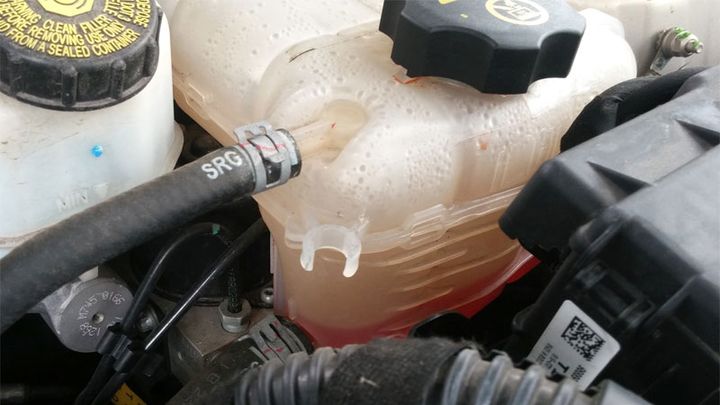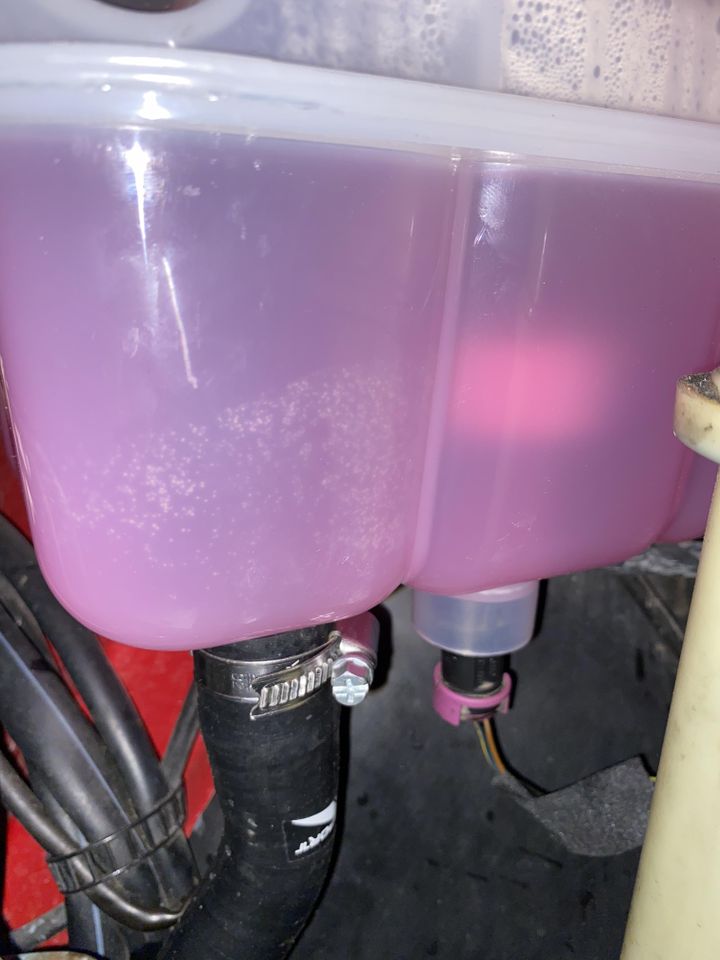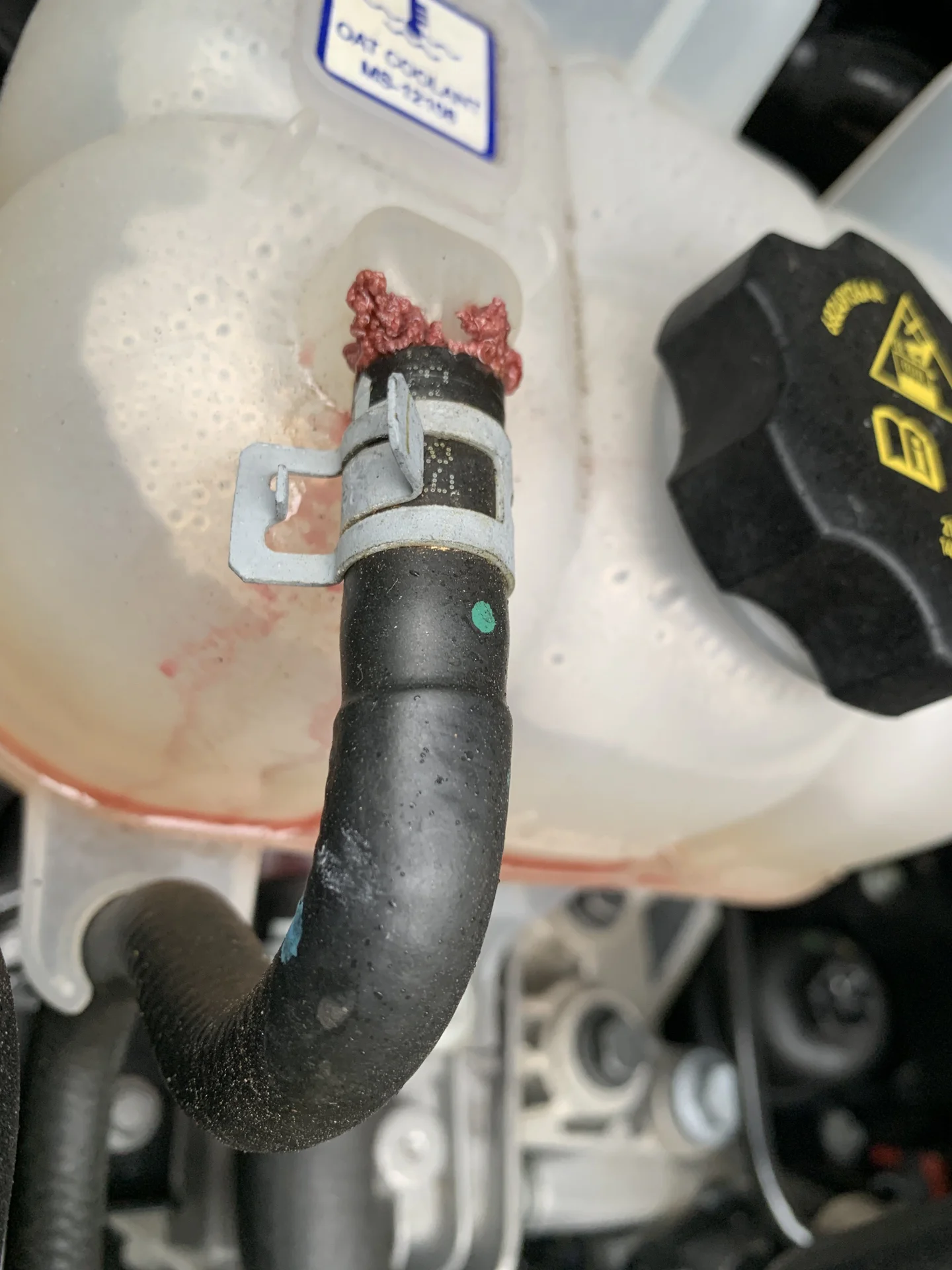


The coolant reservoir is a plastic or metal tank that holds excess coolant in your vehicle's cooling system. It is connected to the radiator via a series of hoses and serves several essential functions:
Function
Description
Expansion
Allows for coolant expansion as it heats up, preventing pressure buildup
Recovery
Enables coolant to be drawn back into the radiator when the engine cools down
Monitoring
Provides a transparent side or markings for easy coolant level checks
The coolant reservoir plays a vital role in ensuring the proper functioning of your vehicle's cooling system. It helps to:
Regulate pressure: The reservoir and its cap maintain the appropriate pressure within the cooling system, preventing boiling and cavitation.
Prevent air pockets: By providing a constant source of coolant, the reservoir helps to eliminate air pockets that can lead to overheating and damage.
Facilitate maintenance: The reservoir allows for easy coolant level checks and provides a convenient point for adding coolant when necessary.
The head gasket is a critical component that seals the space between the engine block and the cylinder head. If the head gasket fails, it can allow combustion gases to enter the cooling system, causing bubbles in the coolant reservoir. This is one of the most serious causes of a bubbling reservoir and requires immediate attention.
Symptoms of a head gasket leak include:
White smoke from the exhaust
Coolant loss without visible leaks
Overheating engine
Milky oil on the dipstick
Air pockets can form in the cooling system after a coolant flush or repair. As the engine heats up, these air pockets expand, causing bubbles in the reservoir. Bleeding the cooling system properly can help to remove these air pockets and resolve the issue.
To bleed the cooling system:
Park the vehicle on a level surface and allow the engine to cool completely.
Locate the bleeder valve, usually near the thermostat housing or radiator.
Open the valve and allow any trapped air to escape until coolant starts to flow out.
Close the valve and top up the coolant reservoir to the proper level.
If the coolant level in the system is too low, it can cause the remaining coolant to boil and create bubbles in the reservoir. Low coolant levels can be caused by leaks, evaporation, or neglecting to top up the reservoir regularly.
To check the coolant level:
Ensure the engine is cool before opening the reservoir cap.
Check the markings on the reservoir to see if the coolant level is between the "MIN" and "MAX" lines.
If the level is low, add a 50/50 mixture of coolant and distilled water until it reaches the proper level.
The radiator cap is designed to seal the cooling system and maintain the proper pressure. If the cap fails or has the incorrect pressure rating, it can allow the coolant to boil at a lower temperature, causing bubbles in the reservoir.
To test the radiator cap:
Remove the cap when the engine is cool.
Inspect the cap for damage, such as cracks or a worn gasket.
Use a cooling system pressure tester to check if the cap maintains the specified pressure.
Replace the cap if it is damaged or fails the pressure test.
The thermostat is a valve that regulates the flow of coolant between the engine and the radiator. If the thermostat sticks closed, it can prevent coolant from circulating properly, causing the engine to overheat and the coolant to boil.
Symptoms of a malfunctioning thermostat include:
Overheating engine
Fluctuating temperature gauge
Coolant not reaching proper operating temperature
To test the thermostat:
Remove the thermostat from the engine.
Place it in a pot of water and heat the water gradually.
Check if the thermostat opens at the specified temperature (usually around 180°F or 82°C).
Replace the thermostat if it fails to open or opens at the wrong temperature.
The water pump is responsible for circulating coolant through the engine and radiator. A failing water pump can't maintain proper coolant flow, leading to hot spots and boiling in the system.
Symptoms of a faulty water pump include:
Coolant leaks from the pump
Whining or grinding noises from the pump
Overheating engine
To diagnose a faulty water pump:
Inspect the pump for visible leaks or damage.
Check for play in the pump shaft by attempting to wiggle the pulley.
Listen for unusual noises coming from the pump while the engine is running.
Replace the water pump if it shows signs of failure.
A clogged or damaged radiator can restrict coolant flow and prevent proper heat dissipation. This can cause the coolant to overheat and boil, resulting in bubbles in the reservoir.
Symptoms of a clogged or damaged radiator include:
Overheating engine
Coolant leaks
Visible damage or corrosion on the radiator
To diagnose a clogged or damaged radiator:
Inspect the radiator for visible leaks, damage, or corrosion.
Check for obstructions in the radiator fins, such as debris or bent fins.
Perform a pressure test to check for internal leaks or blockages.
Flush the radiator to remove any buildup or contamination.
Repair or replace the radiator if necessary.
A cracked cylinder head can allow combustion gases to enter the cooling system, causing bubbles in the reservoir. This is a serious issue that requires immediate attention and often necessitates cylinder head replacement.
Similar to a cracked cylinder head, a cracked engine block can allow gases to enter the cooling system, leading to bubbling in the reservoir. This is a critical problem that may require engine replacement in severe cases.

The most obvious symptom of a bubbling coolant reservoir is the presence of visible bubbles or boiling in the tank. These bubbles may appear as small, rapidly forming bubbles or larger, more sluggish bubbles, depending on the underlying cause.
If you notice bubbles in the reservoir, it's essential to investigate the issue promptly to prevent further damage to the cooling system and engine.
When the coolant in the reservoir boils, it can cause the liquid to overflow from the tank. This overflow may be visible as coolant pooling around the reservoir or dripping onto the ground beneath the vehicle.
Coolant overflow can lead to a low coolant level in the system, which can exacerbate the overheating problem and cause engine damage if left unchecked.
A bubbling coolant reservoir is often accompanied by an overheating engine. If the temperature gauge on your dashboard reads higher than normal or enters the red zone, it's a clear indication that your cooling system is not functioning properly.
Overheating can cause severe damage to engine components, such as warping the cylinder head, cracking the block, or damaging gaskets and seals. If you notice your engine overheating, pull over and turn off the engine as soon as it is safe.
In some cases, a bubbling coolant reservoir may be accompanied by steam or vapor emanating from the engine bay. This steam is a result of the coolant boiling and escaping from the system.
If you notice steam coming from under the hood, it's crucial to exercise caution when investigating the issue. Allow the engine to cool completely before attempting to open the hood or touch any components, as the steam and hot coolant can cause severe burns.

The first step in diagnosing a bubbling coolant reservoir is to check the coolant level. Ensure the engine is cool before attempting to open the reservoir cap, as the system may be under pressure, and hot coolant can cause injury.
Check the markings on the reservoir to see if the coolant level is between the "MIN" and "MAX" lines. If the level is low, it may indicate a leak in the system or simply a need to top up the coolant.
If the coolant level is consistently low, inspect the cooling system for leaks. Check the radiator, hoses, water pump, and engine block for signs of coolant leakage. Pay attention to any pooling coolant beneath the vehicle or visible wet spots on components.
Leaks can be caused by:
Damaged or deteriorated hoses
Loose or faulty hose clamps
Cracked or corroded radiator
Failing water pump seals
Damaged head gasket or engine block
A pressure test can help identify leaks or weak points in the cooling system. To perform a pressure test:
Allow the engine to cool completely.
Remove the radiator cap and attach the pressure tester to the radiator opening.
Pump the tester to the specified pressure (usually listed on the radiator cap).
Observe the gauge for any pressure drops, which indicate a leak in the system.
Inspect the system for the source of the leak, such as hoses, gaskets, or the radiator itself.
Monitoring the engine temperature is crucial when diagnosing a bubbling coolant reservoir. Use a scan tool or the vehicle's temperature gauge to check if the engine is operating within the normal temperature range.
If the engine is overheating, it may indicate a problem with the thermostat, water pump, radiator, or other cooling system components. An infrared thermometer can also be used to check for hot spots on the radiator or engine, which may help pinpoint the source of the issue.
If a head gasket leak is causing the bubbling coolant reservoir, the gasket must be replaced. This is a complex repair that requires removing the cylinder head and should be performed by a qualified mechanic.
The head gasket replacement process typically involves:
Draining the coolant and disconnecting the battery.
Removing the cylinder head and old head gasket.
Inspecting the cylinder head and block for warping or damage.
Installing a new head gasket and reassembling the engine.
Refilling the cooling system with fresh coolant and bleeding any air pockets.
If the cylinder head is cracked or severely warped, it may need to be repaired or replaced. A machine shop can inspect the cylinder head and determine if it can be resurfaced or if replacement is necessary.
Cylinder head repair or replacement involves:
Removing the damaged cylinder head.
Inspecting the head for cracks or warping.
Resurfacing the head if possible, or replacing it with a new or reconditioned unit.
Reinstalling the cylinder head with a new head gasket.
Reassembling the engine and refilling the cooling system.
If a faulty component is causing the bubbling coolant reservoir, it must be replaced to restore proper cooling system function. Common components that may need replacement include:
A faulty radiator cap can allow the coolant to boil at a lower temperature. Replace the cap with a new one that matches the specified pressure rating for your vehicle.
A stuck or failing thermostat can prevent proper coolant circulation. Replace the thermostat with a new one that opens at the correct temperature for your engine.
A failing water pump can cause poor coolant circulation and overheating. Replace the water pump with a new unit, ensuring proper installation and gasket sealing.
A clogged, corroded, or leaking radiator can hinder heat dissipation and cause overheating. Flush the radiator to remove any blockages, or replace it if it is beyond repair.
After addressing the underlying cause of the bubbling coolant reservoir, it's essential to flush the cooling system and refill it with fresh coolant. This process helps to remove any contamination or debris that may have accumulated in the system.
To flush and refill the cooling system:
Drain the old coolant from the radiator and engine block.
Fill the system with a cooling system flush solution and water.
Run the engine with the heater on until it reaches operating temperature.
Drain the flush solution and refill the system with a 50/50 mix of new coolant and distilled water.
Bleed any air pockets from the system and check for leaks.
After refilling the cooling system, it's crucial to bleed any trapped air pockets to ensure proper coolant circulation. Air pockets can cause localized overheating and bubbling in the reservoir.
To bleed air from the cooling system:
Locate the bleeder valve, usually near the thermostat housing or radiator.
With the engine cool, open the valve and allow coolant to flow until any air bubbles have escaped.
Close the valve and top up the coolant reservoir to the proper level.
Run the engine with the heater on and monitor the temperature gauge and reservoir for any further issues.
To keep your cooling system in optimal condition, it's essential to change the coolant at the intervals specified in your vehicle's owner's manual. Over time, coolant can break down and lose its anti-corrosive and anti-freeze properties, leading to system damage and overheating.
When changing the coolant:
Drain the old coolant from the radiator and engine block.
Flush the system with distilled water to remove any debris or contamination.
Refill the system with a 50/50 mix of new coolant and distilled water.
Bleed any air pockets and check for leaks.
Regularly inspect the cooling system hoses and components for signs of wear, damage, or leaks. Check for:
Soft, brittle, or cracked hoses
Loose or damaged hose clamps
Corrosion or leaks on the radiator, water pump, or thermostat housing
Proper tension on the water pump and alternator belts
Replace any damaged components promptly to prevent cooling system failures and overheating.
Keep an eye on your vehicle's temperature gauge while driving to ensure the engine is operating within the normal range. If you notice the temperature consistently running higher than usual or approaching the red zone, have the cooling system inspected by a professional.
Catching temperature issues early can help prevent more severe damage and costly repairs down the line.
If your engine does overheat, it's crucial to address the issue promptly to minimize damage. If you notice the temperature gauge climbing or see steam from under the hood:
Pull over and turn off the engine as soon as it is safe to do so.
Allow the engine to cool completely before attempting to open the hood.
Check the coolant level in the reservoir and add coolant if needed.
Inspect the system for any visible leaks or damage.
If the issue persists, have the vehicle towed to a repair shop for a thorough diagnosis.
Continuing to drive an overheating engine can lead to severe damage, such as war ped cylinder heads, cracked engine blocks, or damaged internal components.
By taking care of your vehicle's cooling system and addressing any issues that arise, you can ensure your engine runs at optimal temperatures and avoid costly repairs down the road. Remember, a well-maintained cooling system is essential for the longevity and reliability of your vehicle.
The most common causes of a bubbling coolant reservoir include a blown head gasket, air pockets in the cooling system, and a faulty radiator cap. These issues allow air to enter the sealed cooling system, causing bubbles and potential overheating.
It is not recommended to drive your vehicle if the coolant is bubbling, as it indicates a serious issue within the cooling system. Continuing to drive with a bubbling coolant reservoir can lead to engine overheating and severe damage.
If the bubbles in the coolant reservoir are caused by a blown head gasket, you may also notice white smoke from the exhaust, coolant loss without visible leaks, an overheating engine, and a milky substance on the oil dipstick. A mechanic can perform a compression test to confirm a blown head gasket.
To diagnose and repair a bubbling coolant reservoir, you may need tools such as a coolant pressure tester, a thermometer, a wrench set, a screwdriver, pliers, and a funnel. Always refer to your vehicle's manual for specific tools and instructions.
It is recommended to flush your vehicle's cooling system every 30,000 miles or every two years, whichever comes first. However, always consult your vehicle's owner's manual for the manufacturer's recommended maintenance schedule.
Yes, a bubbling coolant reservoir can lead to engine overheating. The air bubbles in the system disrupt the proper circulation of coolant, preventing it from effectively absorbing heat from the engine components.
No, it is never safe to open the radiator cap when the engine is hot. The cooling system is pressurized, and opening the cap when the engine is hot can cause the hot coolant to spray out, leading to serious burns.
The cost to replace a blown head gasket can vary greatly depending on the make and model of your vehicle, but it typically ranges from $1,000 to $2,000 or more. This is because the repair involves significant labor and parts costs.
Old coolant should be disposed of properly at a designated recycling facility or an auto parts store that accepts used coolant. Never pour old coolant down the drain or onto the ground, as it is toxic and can harm the environment.
Yes, a bubbling coolant reservoir can lead to damage to other engine components if left unaddressed. Overheating caused by the disrupted coolant flow can warp cylinder heads, crack the engine block, and damage gaskets and seals.

Miguel started tinkering with car radios as a teenager, fascinated by the intricate dance of wires and circuits. This passion led him to pursue a career as an automotive electrician. For the past 10 years, Miguel has tackled everything from flickering headlights to mysterious electrical gremlins. He thrives on troubleshooting electrical problems and enjoys sharing his knowledge to empower car owners to understand their vehicles better.








